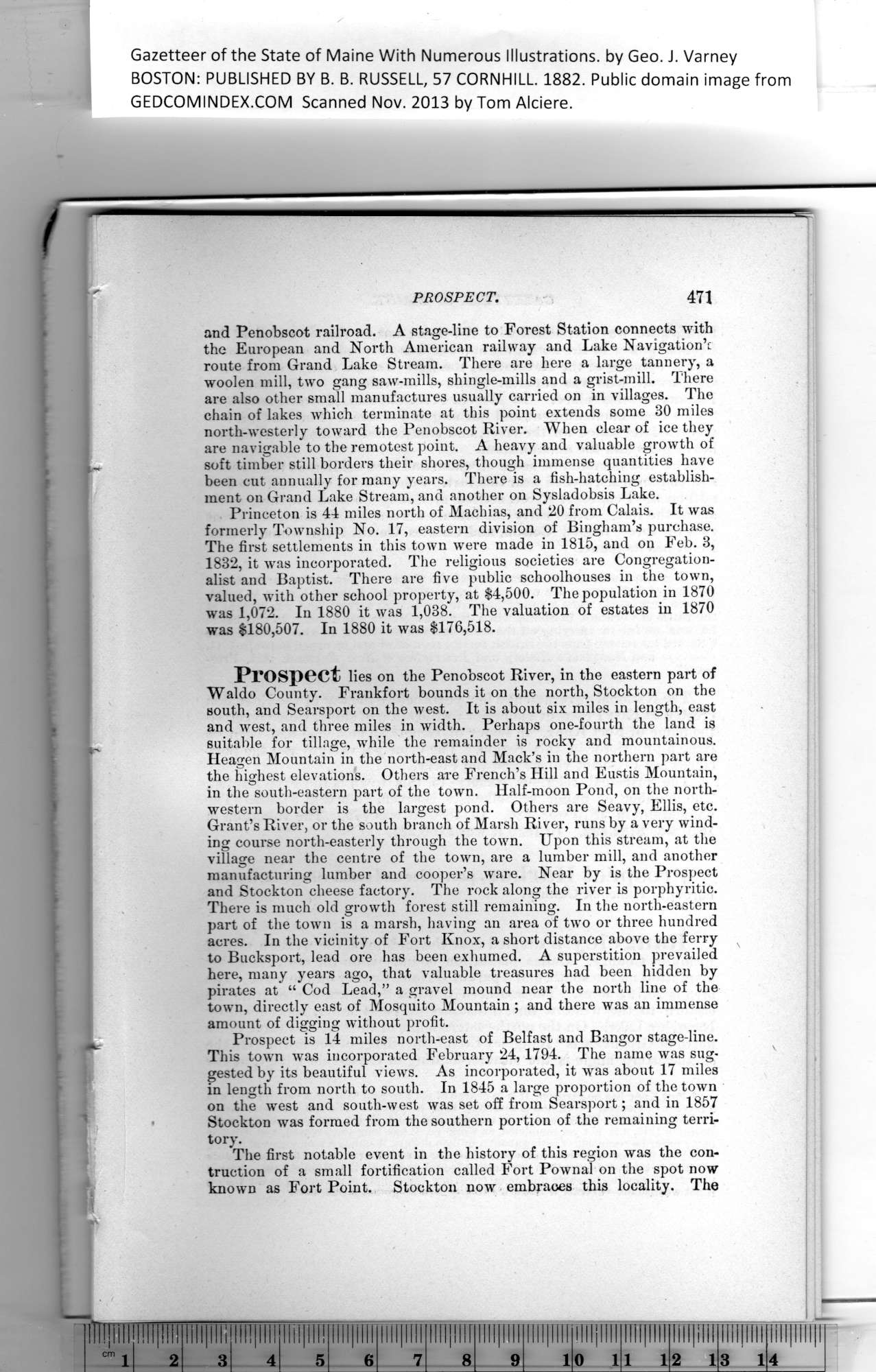|
Gazetteer of the State of Maine With Numerous Illustrations, by Geo. J. Varney
BOSTON: PUBLISHED BY B. B. RUSSELL, 57 CORNHILL. 1882. Public domain image from
| :-
!
PROSPECT. 471
and Penobscot railroad. A stage-line to Forest Station connects with
the European and North American railway and Lake Navigation^
route from Grand Lake Stream. There are here a large tannery, a
woolen mill, two gang saw-mills, shingle-mills and a grist-mill. There
are also other small manufactures usually carried on in villages. The
chain of lakes which terminate at this point extends some 30 miles
north-westerly toward the Penobscot River. When clear of ice they
are navigable to the remotest point. A heavy and valuable growth of
soft timber still borders their shores, though immense quantities have
been cut annually for many years. There is a fish-hatching establish-
ment on Grand Lake Stream, and another on Sysladobsis Lake.
. Princeton is 44 miles north of Machias, and 20 from Calais. It was
formerly Township No. 17, eastern division of Bingham’s purchase.
The first settlements in this town were made in 1815, and on Feb. 3,
1832, it was incorporated. The religious societies are Congregation-
alist and Baptist. There are five public schoolhouses in the town,
valued, with other school property, at $4,500. The population in 1870
was 1,072. In 1880 it was 1,038. The valuation of estates in 1870
was $180,507. In 1880 it was $176,518.
Prospect lies on the Penobscot River, in the eastern part of
Waldo County. Frankfort bounds it on the north, Stockton on the
south, and Searsport on the west. It is about six miles in length, east
and west, and three miles in width. Perhaps one-fourth the land is
suitable for tillage, while the remainder is rocky and mountainous.
Heagen Mountain in the north-east and Mack’s in the northern part are
the highest elevations. Others are French’s Hill and Eustis Mountain,
in the south-eastern part of the town. Half-moon Pond, on the north-
western border is the largest pond. Others are Seavy, Ellis, etc.
Grant’s River, or the south branch of Marsh River, runs by a very wind-
ing course north-easterly through the town. Upon this stream, at the
village near the centre of the town, are a lumber mill, and another
manufacturing lumber and cooper’s ware. Near by is the Prospect
and Stockton cheese factory. The rock along the river is porphyritic.
There is much old growth forest still remaining. In the north-eastern
part of the town is a marsh, having an area of two or three hundred
acres. In the vicinity of Fort Knox, a short distance above the ferry
to Bucksport, lead ore has been exhumed. A superstition prevailed
here, many years ago, that valuable treasures had been hidden by
pirates at “ Cod Lead,” a gravel mound near the north line of the
town, directly east of Mosquito Mountain ; and there was an immense
amount of digging without profit.
Prospect is 14 miles north-east of Belfast and Bangor stage-line.
This town was incorporated February 24,1794. The name was sug-
gested by its beautiful views. As incorporated, it was about 17 miles
in length from north to south. In 1845 a large proportion of the town
on the west and south-west was set off from Searsport; and in 1857
Stockton was formed from the southern portion of the remaining terri-
tory.
The first notable event in the history of this region was the con-
traction of a small fortification called Fort Pownal on the spot now
known as Fort Point. Stockton now embraces this locality. The
PREVIOUS PAGE ... NEXT PAGE
This page was written in HTML using a program written in Python 3.2
|
